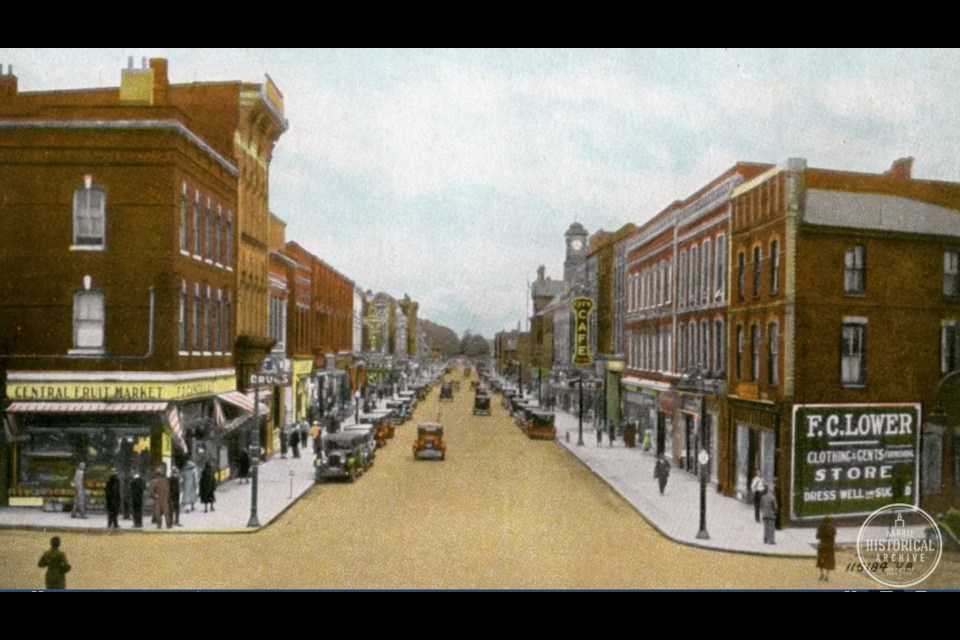They still call it Five Points, but some would argue that the name for Barrie’s most well-known intersection no longer applies. The points have been disappearing.
Two years ago, I took a look at the southeastern point, the one that housed a Tim Hortons coffee shop until recently. There, under a modern façade, lies remnants of an 1870s-era building.
None of the famed Five Points escaped doing battle with fire, but the northeastern point may have been the most scorched of them all. As is evident, one final blaze claimed the whole corner eventually.
The Bank of Toronto building, built by Francis Steevens about 1852, was one of the earliest structures built of brick in Barrie. It was rather unusual at the time for this small back-country town.
If Francis Steevens thought he had outsmarted Barrie’s oldest foe, the flames of destructive fire, he was in for an unpleasant surprise. Certainly, when the south side of Dunlop Street burned in 1871, Steevens must have congratulated himself on his fine choice of building material.
Not so fast, Mr. Steevens.
In 1873, when the Bank of Toronto vacated the corner building, it was converted into the appropriately named Bank Hotel. In late 1874, the hotel was doing very well under the management of Charles Clarkson, who boasted some fine offerings in an ad placed in the Northern Advance.
“The bar is fitted up in first-class style and liquors and cigars of the choicest brands can always be had. The stabling is good and ample. The best of accommodation is offered to travellers and boarders, as the rooms are light and airy, and the best of board is to be had. An attentive ostler always in attendance.”
Then came that fateful day in June 1975, four years to the day after the fire that saw the entire Glebe Block across the street reduced to ashes. When it was over, nothing remained but a few partial walls and the solidly built bank vault within the hotel.
Even as it lay in ruins, the Bank Hotel was credited with preventing the fire from crossing the Five Points and destroying the Simcoe Hotel, the Wellington Hotel and other buildings. A catastrophe of that kind would come the following year.
The hotel was soon rebuilt and then came into the hands of Thomas Summersett who had managed a number of Barrie hotels. The Bank Hotel was rebranded as Summersett House.
Summersett House continued on even after the death of Thomas Summersett in 1884. It was operated by a Mr. Crocket into the 1890s and was converted into a store in 1893.
Before 1900, H.H. Otton & Sons relocated their hardware business to the corner after a spot next to the Barrie Hotel, now known as the Queen’s Hotel.
In 1928, Henry Holt Otton died as a result of an automobile accident. By that time, he had been retired for six years and living in Toronto while his son, Fred Otton, ran the Barrie business.
In 1929, fruit merchant Frank D. Cancilla realized a dream he had held onto since boyhood. Raised on his father’s orchard in Palermo, Italy, he had made it his goal to one day operate a prominent green grocery on the most well-known corner of a North American city.
He bought the old Otton store for what was reported to be the priciest purchase of a business building in Barrie’s history. Cancilla went on to sink $6,000 into the shop, over $100,000 in today’s value, to improve the interior and exterior, and to add refrigeration and other upgrades.
Cancilla’s new business at Five Points was called the Central Fruit Market.
In 1942, this was the site of the busy Tamblyn Drug Store. On Dec. 30 of that year, the shop experienced a fire, still remembered well by the long-times of this city. Yet, this corner building carried on.
The corner ceased to be occupied after one final fire in January 1994. At that time, Sam the Record Man was the tenant in the building. The site has been vacant now for almost 30 years and has been used mainly for outdoor dining for adjacent restaurants.
Each week, the Barrie Historical Archive provides BarrieToday



